
by Polina Yan
Flirting has moved into the chat box. A wink emoji, a half-serious line dropped into Messenger, a long thread of late-night banter — most connections now start and grow through text. But here’s the thing: not everyone knows what to say, and even the smoothest talker runs dry sometimes. That’s where an AI flirty text generator comes in.
Think of it as backup for your brain. Fire it up, and you’ve got a tool that can suggest playful openers, craft a cheeky response, or carry on a spicy roleplay chat without running out of steam. Some people use it for dating apps, others for more explicit spaces where adult creators keep fans entertained in private messages. The draw is the same: it keeps the conversation flowing.
In the pages ahead, we’ll unpack how these generators work, where they shine, and which five stand out in 2025 — plus how Scrile Connect lets you build one of your own.
What Is an AI Flirty Text Generator?
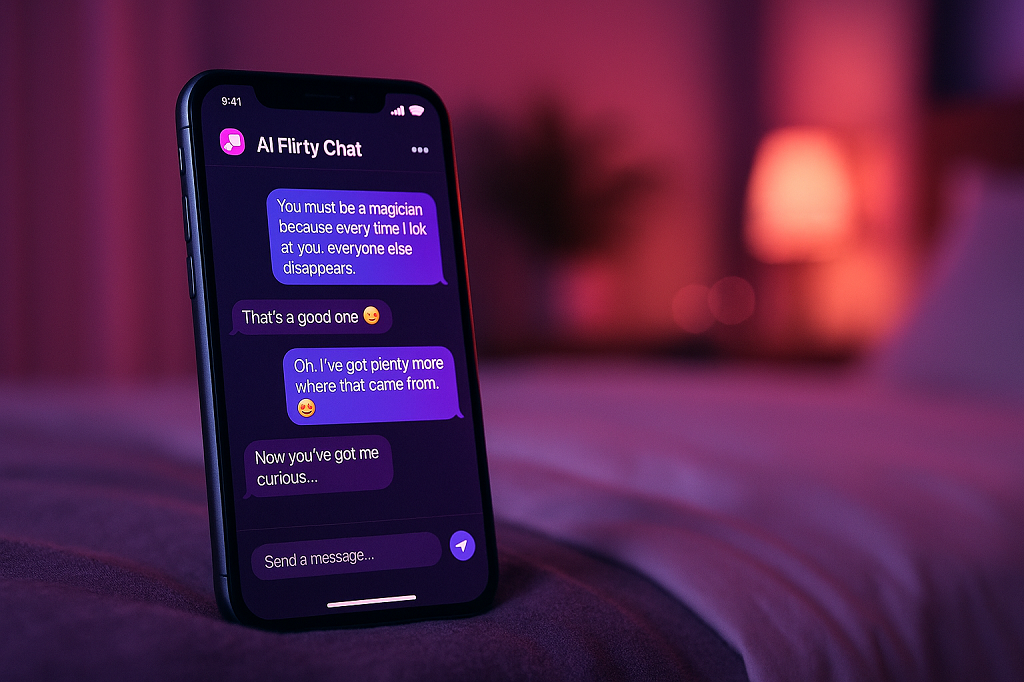
At its core, an AI flirty text generator is software built to handle the kind of conversations that usually make people pause and overthink. Instead of staring at the blinking cursor, you can let the system throw out playful suggestions, smooth compliments, or even entire replies that keep the mood alive. The tech behind it isn’t magic — it’s natural language processing, fine-tuned conversation models, and personality presets that give the AI a certain “voice.”
In practice, this means you can set the tone. Want witty and lighthearted? It can do that. Prefer sultry or more direct? That’s just a switch of a setting. Some tools even allow you to train the model with your own chat history so the replies feel more personal, less like something borrowed from the internet.
People use these tools in different ways. A teenager might lean on one for courage when texting a crush. Long-distance couples often use them to keep the spark alive across time zones. Adult creators go a step further, turning the AI into a sexting companion that scales conversations with dozens of fans at once. In those scenarios, the software isn’t just fun — it’s part of the business.
Of course, a flirty text response generator AI isn’t flawless. Without enough context, the output can feel generic or slightly off. Sometimes the AI misses sarcasm or tone, which can create awkward moments. But when it works, it takes the pressure off and helps people focus less on typing the “perfect” line and more on enjoying the exchange.
Why Use AI for Flirting? Benefits & Use Cases

Flirting through text is fun, but also stressful. Thinking too long about a reply can kill the moment, and running out of ideas makes conversations flat. An AI flirty text generator helps keep the spark alive by throwing out playful lines, cheeky one-liners, or even handling an entire roleplay chat when you’re too tired to think.
What makes these tools popular is how many different roles they can play. People use them for fun, for business, and sometimes just for emotional support.
Key Areas Where AI Flirty Text Generators Shine:
- Entertainment and dating apps: Many singles rely on AI for flirting to avoid dry conversations. Instead of the boring “hey, what’s up,” they get smart suggestions that help them stand out.
- Long-distance relationships: When calls aren’t possible, AI for texting can help couples keep their daily chats fresh with creative prompts and playful messages.
- Adult creators and webcam performers: Handling dozens of private chats a day is exhausting. An AI assistant can cover flirty banter at scale, helping creators make fans feel noticed while focusing their real energy on the highest-value interactions.
- Companionship for lonely users: Not everyone uses these tools for dating. Some people just want to feel less isolated. A flirty text response generator AI can simulate intimacy and conversation, making late nights less quiet and giving users the sense of being cared for.
- Roleplay and fantasy: For fans of interactive storytelling, AI tools can take on different characters, moods, or tones, bringing imagination into chat form.
- Coaching and confidence building: Practicing lines in private builds social skills. Users can test humor, boldness, or timing with AI before trying the same in real life.
- Education and workshops: Some online coaches even integrate these tools into lessons on communication, showing students how different approaches change the feel of a conversation.
From casual dating to adult services, from practicing confidence to simply having someone “there,” an AI flirty text generator makes it easier to start, sustain, and enjoy conversations.
5 Best AI Flirty Text Generators in 2025
AI has crept into every corner of online life, and flirting is no exception. An AI flirty text generator can throw out witty one-liners, keep a conversation playful, or even build long-term roleplay threads. For some, it’s about spicing up dating app chats. For others, it’s companionship — a way to ease loneliness with a digital partner who never runs out of things to say. The tools on this list cover the spectrum, from lighthearted banter to fully NSFW sexting engines.
Replika
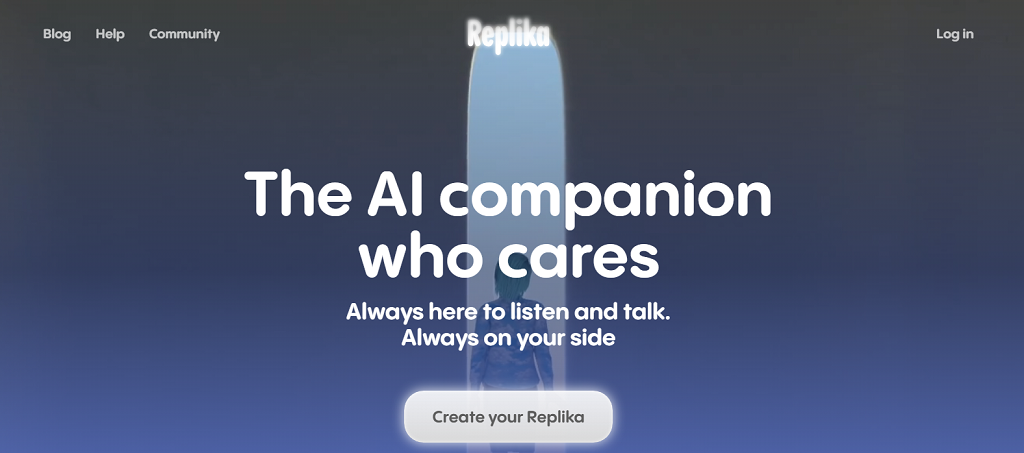
Replika is one of the best-known AI companions and remains a popular choice in 2025. It started as a general friend-bot but has grown into something closer to a customizable partner, with modes that support flirting and romance. Many people use it for emotional connection, while others enjoy it as a gentle entry point into AI-powered intimacy.
Features
- Personality that adapts over time, remembering details and building continuity.
- Flirty conversation mode that can shift tone depending on how bold you want it.
- Optional NSFW features for users who want something beyond sweet talk.
Pros
- Conversations feel personal because of memory and emotional cues.
- Easy to start — no steep learning curve.
- Works on mobile and desktop with a clean interface.
Cons
- Flirty interactions can feel soft compared to more explicit apps.
- Extra features often locked behind a paywall.
- Limited control over how far adult content can go.
Replika works best for people looking for consistency and warmth. It’s not the raciest option, but as an AI flirty text generator it delivers a sense of stability that many find comforting.
CrushOn.AI
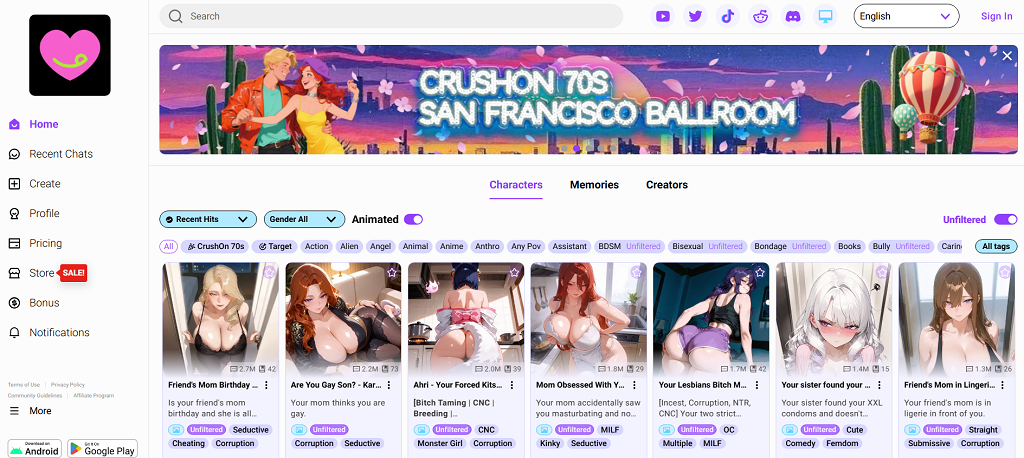
CrushOn.AI is built for people who don’t want filters holding them back. Unlike softer apps, it leans heavily into explicit conversations and roleplay. The design is simple: you pick or design a character, set their personality, and the system generates dialogue that adapts to the mood you create. It’s one of the few options where NSFW is a central selling point rather than a quiet add-on.
Features
- Custom character creation with sliders for personality, tone, and kinks.
- Fully NSFW roleplay options without strict limitations.
- Ability to save scenarios and return to them later.
Pros
- Ideal for adult users who want unfiltered, spicy chat.
- Highly customizable personalities make every experience unique.
- Strong focus on roleplay compared to casual conversation bots.
Cons
- Less emphasis on emotional bonding, more on fantasy.
- Interface can feel clunky compared to mainstream apps.
- Free tier is very restricted, pushing users toward paid plans quickly.
CrushOn.AI works well for anyone searching for an AI flirt app that’s upfront about being erotic and customizable. It’s less about companionship and more about immersive, adult scenarios.
ChatGPT (with Flirty Personality Prompts)
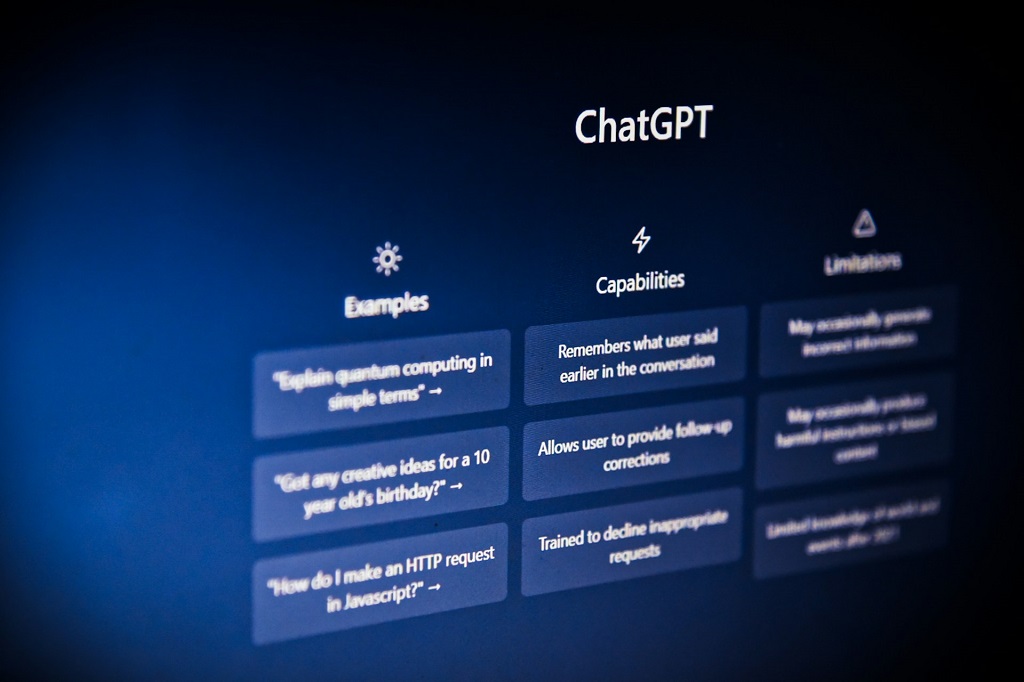
ChatGPT isn’t marketed as a dating or flirty tool, but creative users have been bending it into one. With the right prompts, it can shift tone toward playful, cheeky, or romantic conversation. Some people even use it to draft lines before sending them in real chats, treating it as a brainstorming partner rather than a companion.
Features
- Adaptable tone: can move from professional writing to playful banter with a simple prompt.
- Works across multiple apps and platforms thanks to integrations.
- Creative flexibility: users decide the persona, from casual flirt to fantasy roleplay.
Pros
- Extremely flexible compared to specialized tools.
- Great for drafting responses that feel natural.
- Large knowledge base makes it versatile beyond flirting.
Cons
- Doesn’t remember conversations well without extra setup.
- Not designed for intimacy, so replies can feel generic.
- Requires user effort to guide tone and avoid dullness.
ChatGPT is the Swiss Army knife of AI texting. It’s not marketed as an AI flirty text generator, but for people who like experimenting, it doubles as a powerful sandbox to shape their own playful partner.
Anima AI
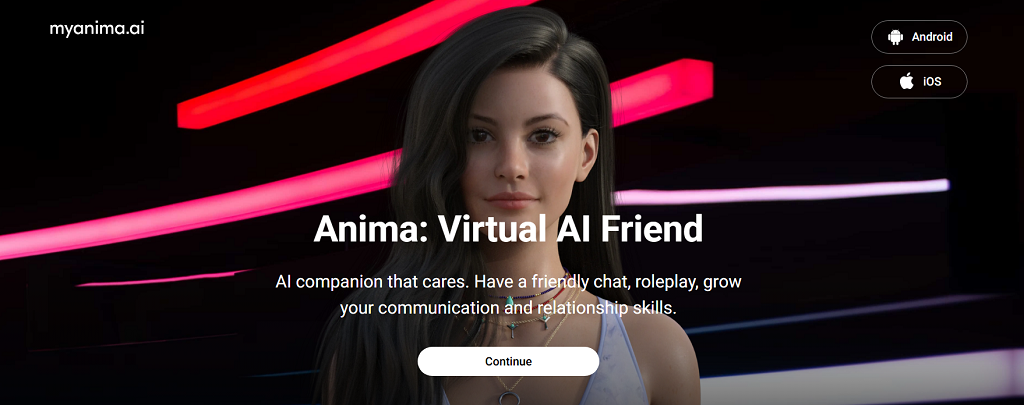
Anima AI positions itself as a virtual companion first, but it has steadily gained popularity as a playful chat partner. Its main draw is the focus on roleplay and light romance. Younger users often test it out as a low-pressure way to practice flirting, while others enjoy it as a casual digital companion that’s always available.
Features
- Customizable avatars with different looks and personalities.
- Roleplay settings ranging from sweet to teasing, with mild adult elements.
- Conversation memory that helps maintain consistency across chats.
Pros
- Friendly entry point for people new to AI companionship.
- Visual avatars add to immersion, not just text.
- Offers a balance between fun and emotional support.
Cons
- NSFW capabilities are limited compared to explicit apps.
- Dialogue can repeat if you push longer conversations.
- Some features feel paywalled, especially personalization.
Anima AI isn’t the most advanced or risqué option, but it fills a niche. For users who want an approachable AI flirt app that mixes lighthearted romance with companionship, it’s a comfortable fit.
Candy.ai

Candy.AI markets itself directly as an adult-first AI companion. Unlike softer apps, it leans heavily into NSFW sexting and explicit roleplay. Personalization is a big part of the appeal: users can design their AI partner’s look, style, and conversational personality to match specific fantasies.
Features
- Explicit sexting and roleplay modes baked into the core experience.
- Detailed customization of characters, from looks to dialogue tone.
- Ongoing chat memory for more realistic interactions.
Pros
- One of the most direct adult-oriented tools available.
- Deep customization means you can build a partner tailored to your preferences.
- Strong appeal for people looking for explicit companionship rather than general conversation.
Cons
- Little focus on emotional support — fantasy comes first.
- Not as polished in design as mainstream apps.
- Subscription costs can add up quickly for heavy users.
Candy.AI makes no secret of its intent: it’s for explicit companionship. For users who want an AI flirty text generator that’s bold, customizable, and adult-only, it stands out as one of the more daring entries on the list.
Scrile Connect: Build Your Own AI Flirty Text Generator
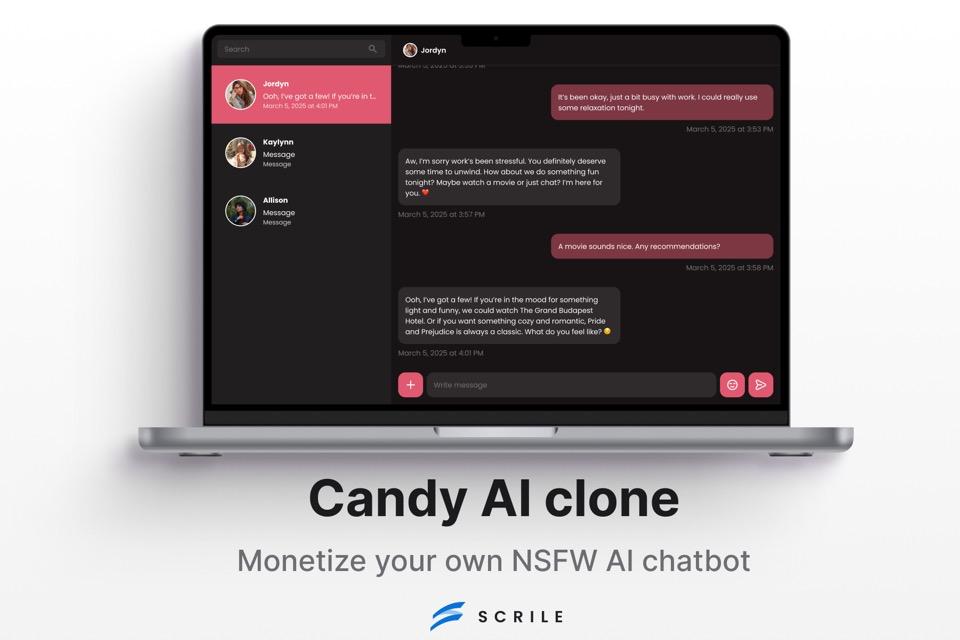
Most of the apps in this list are built for mass audiences. They’re polished, easy to download, and quick to start using — but they’re also limited. You don’t own the brand, you can’t control the roadmap, and revenue always flows through someone else’s system. Scrile Connect takes a different route. It isn’t a ready-made app at all. It’s a development service that builds a white-label solution designed around your vision.
With Scrile Connect, your AI project carries your brand, domain, and design. Want a sleek modern UI? Or a more playful, adult-friendly layout? The service adapts. Under the hood, it supports advanced features like creating your own AI girlfriend, fine-tuning personalities, selling AI art directly to fans, and managing subscriptions without middlemen. For monetization, the toolkit includes recurring subs, one-time tips, pay-per-chat access, and premium content paywalls — everything creators or businesses need to keep revenue flowing.
This isn’t just an app; it’s full AI flirting platform development. That means NSFW readiness, flexible integration with payments, and zero restrictions from third-party vendors. Instead of being stuck with what an app allows, you shape the rules and keep ownership.
Possible use cases with Scrile Connect include:
- Dating startups that want to launch their own branded AI chat service.
- Adult cam agencies scaling private chat and premium content with custom-built AI companions.
- Niche roleplay communities seeking tailored personality-driven conversation engines.
- AI art sellers combining flirty avatars with creative digital content on their own site.
Scrile Connect stands out because it hands control back to the business. No revenue cuts, no platform branding, no ceiling on creativity — just a custom build that reflects exactly what you want to offer.
Conclusion
AI flirty text tools have become more than novelties — they’re playful, practical, and in many cases, profitable. The five apps highlighted here each cater to different needs, from gentle companionship to bold, explicit roleplay. But all of them share the same limitation: they’re closed systems.
Scrile Connect breaks that mold. As a development service, it lets you create something entirely your own — branded, monetized, and flexible enough to grow with your audience. If you’re ready to take control, explore Scrile Connect and build an AI flirty text generator that’s truly yours.
Polina Yan is a Technical Writer and Product Marketing Manager, specializing in helping creators launch personalized content monetization platforms. With over five years of experience writing and promoting content, Polina covers topics such as content monetization, social media strategies, digital marketing, and online business in adult industry. Her work empowers online entrepreneurs and creators to navigate the digital world with confidence and achieve their goals.

by Polina Yan
Ever wished for a personal assistant who never needs sleep, never forgets, and always has the right answer? In 2025, the best AI assistants are stepping into this role, offering virtual support that goes far beyond basic automation. These digital helpers manage everything from scheduling meetings and setting reminders to generating creative content and even managing smart home devices.
AI assistants are no longer just for tech enthusiasts. They have become essential tools for businesses, creators, and everyday users who want to save time and boost productivity. Whether you need help organizing your day, interacting with customers, or simply setting the perfect ambiance at home, there’s an AI assistant designed to make life easier.
In this article, we’ll explore the top AI assistants of 2025. We’ll look at big names like Google Assistant, Amazon Alexa, and Apple Siri, as well as innovative tools like ChatGPT, Motion AI and custom solutions from Scrile AI. Each assistant brings unique features to the table, making it easier to find the perfect fit for your needs—whether for personal tasks or professional productivity. Let’s find out what makes the best AI assistant and discover which one might become your new favorite virtual helper.
Top 7 AI Assistants in 2025 – Quick Comparison
| Assistant | Best For | Strengths | Limitations | Ecosystem Fit |
|---|
| Google Assistant | Everyday + work routines | Google Workspace & smart home integration, proactive suggestions | Best inside Google ecosystem | Google users |
| Amazon Alexa | Smart home + retail tasks | Huge device network, “Skills” marketplace, shopping & automation | Less natural conversation; retail bias | Amazon ecosystem |
| Apple Siri | Apple device owners | Seamless iOS/macOS integration, HomeKit control, messaging | Limited outside Apple hardware | Apple ecosystem |
| Microsoft Cortana | Office productivity | Deep Microsoft 365 integration, meeting scheduling, smart suggestions | Phasing out for consumer use | Windows/Office users |
| Samsung Bixby | Samsung smart devices | Strong SmartThings control, TV/phone integration | Weak app ecosystem, limited global reach | Samsung ecosystem |
| ChatGPT (OpenAI) | Content & communication | Human-like text replies, content creation, chatbot support | No native voice/device control | Cross-platform |
| Motion AI | Productivity & scheduling | Smart auto-scheduling, task priorities, Slack/Calendar integration | Focused on work tasks only | Teams & professionals |
What is an AI Assistant?

An AI assistant is a smart digital helper designed to manage tasks, answer questions, and streamline both personal and professional activities. These virtual assistants use technologies like natural language processing and machine learning to understand voice commands, manage schedules, set reminders, and control smart home devices.
The best AI personal assistants can integrate with apps and services, providing hands-free convenience for busy professionals and everyday users alike. They excel in business environments, helping with tasks like email management, meeting scheduling, and data organization. On creator platforms and social media, they assist with content generation and audience engagement.
The rise of best AI virtual assistants has transformed how we interact with technology, offering tailored solutions for work productivity and simplifying everyday life. Whether managing a to-do list, setting up a smart home, or enhancing business communications, AI assistants bring efficiency and ease to daily routines.
Benefits of Using an AI Assistant
AI assistants bring many benefits to both personal and professional life. They help users stay organized, manage tasks efficiently, and maintain a consistent communication style in business settings. Here are the top advantages of using an AI personal assistant for business and everyday use:
- Increases Productivity: AI assistants handle repetitive tasks like scheduling meetings, sending reminders, and organizing calendars. This automation frees up time for more important activities.
- Enhances Time Management: These tools provide smart reminders, integrate with calendars, and help manage daily routines smoothly. They reduce the chances of missed appointments or deadlines.
- Ensures Consistency: Businesses often struggle to maintain a uniform brand voice across all communications. An AI assistant helps keep messages consistent, whether it’s in emails, social media posts, or customer support responses.
- Practical Example: A content creator using a best personal assistant AI can manage fan interactions on social media more efficiently. The assistant can generate quick responses to comments, draft messages, and even schedule posts to maintain regular engagement.
- Versatile Uses: With so many AI assistant names available, choosing who is the best AI assistant depends on specific needs. Some excel at managing business tasks, while others focus on personal organization or creative support.
AI assistants are more than just digital helpers. They act as smart partners that enhance productivity, improve communication, and simplify day-to-day tasks. Whether at work or home, these tools adapt to user needs and make life easier.
Top 7 AI Assistant Tools in 2025
AI assistants are transforming how we manage tasks, automate routines, and enhance productivity. Let’s explore the first set of top AI assistants making waves in 2025:
Google Assistant
Google Assistant is a powerhouse in the AI assistant world. It offers integration to Google Workspace and smart home devices. With voice commands, one can schedule a reminder, schedule a meeting, and manage routine. For instance, one can easily command, “Hey Google, schedule a meeting at 3 PM,” and it will be scheduled to the calendar. It also offers personalized suggestion like an early leave reminder to catch an appointment based on traffic information. Its usage both home and office makes it an option to be considered by the majority.
Amazon Alexa

Amazon Alexa has retail and home automation functions. It connects to various smart devices to control via voice commands lights to home defense systems. Alexa is also an easy tool to use to manage shopping lists, remind one about appointments, and automate office operations. Small businesses employ Alexa to manage stock quantity, orders handling, and office communications automation. Alexa’s “Skills” option offers flexibility to enable users to use the use to suit some specific purposes, be it office or home.
Apple Siri
Siri is an essential AI partner to the user in the Apple ecosystem. It offers seamless integration to the devices manufactured by Apple, thereby making iPhones, iPads, Macs, and smart home devices voice-controlled through the integration through the use of HomeKit. It offers users routine productivity through the sending of messages, reminder creation, and control of smart home devices. It can be used to send a message, play a song, or control the thermostat. The seamless integration that it offers to the other Apple programs and devices makes the usage seamless.
Microsoft Cortana
Microsoft Cortana has been designed specifically to suit office users. It fully supports Windows integration and Microsoft 365. Hence, using it within an office is the best option. Cortana supports the creation of meeting schedules, the creation of reminders, and the organization of the task. Cortana can compose emails and also offer smart suggestions during the meeting. For instance, a professional can instruct Cortana to schedule the day, and it will create a scheduled calendar based on the entries and priority. Its productivity-related functions enable Cortana to be an efficient tool to enhance the productivity of the work.
Samsung Bixby
Samsung Bixby is the most intelligent to be employed by users under the Samsung ecosystem. It offers robust voice control of Samsung devices like smartphones, tablets, smart TVs, and smart home devices. Samsung Bixby can be used to automate the sending of messages, calling, and controlling smart devices through basic voice commands. As an example, one can easily employ the command, “Turn off the lights, Bixby,” and the command will be executed. It supports Samsung’s SmartThings app that offers easier control of devices through one interface.
ChatGPT by OpenAI

who is the best ai assistant
Unlike traditional voice assistants, ChatGPT is a powerful tool for text-based interactions. It excels in content generation, answering questions, and managing online interactions. Many businesses and creators use ChatGPT as a virtual assistant to draft responses, generate content ideas, and engage with audiences. For instance, a social media manager might use ChatGPT to create thoughtful replies to community comments or to brainstorm creative post ideas. It’s also popular for creating automated chatbots that provide human-like customer support.
Motion AI
Motion AI is an efficient tool that supports users to organize schedules, manage work, and be more efficient. It offers the possibility to add smart scheduling, task organization, and reminder automation. As an artificial tool to professional users, Motion AI can help users organize the meeting calendar, assign priority to the tasks, and streamline the workflow. The best way to understand how Motion AI functions is the integration that it offers to use Google Calendar and Slack to automate the routine to allow teams to work strategically.
Which AI Assistant is Right for You?
Choosing the best AI assistant will be a case of one’s specific needs. Google Assistant and Alexa are best used to control the smart home. Siri and Bixby are best used within each respective ecosystem but Cortana is best used within the office. ChatGPT will create sophisticated writing but Motion AI produces the best productivity and task management. Each one has something to bring to the table to create the best pairing to use within the home and the office.. However, there is also another solution if you need something created just for you.
Why Scrile AI is The Best Solution for Building Your Own AI Assistant

Scrile service offers a robust service for creating customized AI assistants tailored to unique business needs. Unlike generic tools, Scrile AI allows businesses to develop AI personal assistants for business or personal use with features and interactions that align perfectly with their brand and goals.
One of the biggest advantages of Scrile AI is its ability to deliver beyond off-the-shelf tools. Instead of using a standard AI assistant, businesses can design solutions specifically for their industry. Scrile solutions support a wide range of markets, including e-commerce, education, tech services, and niche sectors like creator platforms, influencer accounts, dating sites, social media, and adult websites. This adaptability makes it a versatile choice for businesses aiming to integrate a best personal assistant AI that can handle complex interactions.
Real-world adaptability is another strength of Scrile AI solutions. The AI assistants developed through its platform are not static; they learn from interactions, evolve with the business, and remain relevant over time. For example, a business could create an AI assistant that not only automates communication but also provides personalized responses and enhances user engagement. This assistant might manage customer inquiries, support sales teams, or automate social media interactions—showing why Scrile AI is a top choice for building a dynamic and effective AI assistant.
If you’re looking for the best AI assistant for your business, Scrile offers the tools and flexibility to create an assistant that meets your exact needs. It is the ideal platform for those who want a tailored solution instead of a one-size-fits-all approach. Explore how Scrile can help you develop a personalized AI assistant that keeps your brand ahead of the competition.
Off-the-Shelf AI Assistants vs. Scrile AI
| Option | Branding & Ownership | Flexibility | Monetization | Best Fit |
|---|
| Standard AI Assistants (Google, Alexa, Siri, etc.) | Vendor-controlled | Fixed features, limited customization | None | General users & households |
| Scrile AI (Custom Assistant) | 100% branded & owned | Fully customizable: text, voice, NSFW/SFW, CRM hooks | Built-in: subs, tips, PPV | Businesses, creators, niche platforms |
Conclusion
The best AI assistant can make a real difference in both personal and business life. These digital helpers boost productivity, streamline tasks, and offer valuable support in everyday routines. Whether you’re using Google Assistant for smart home control, Amazon Alexa for managing e-commerce tasks, or ChatGPT for content generation, each tool brings unique benefits to the table.
For businesses looking to go beyond generic solutions, Scrile AI offers a unique opportunity. Instead of settling for a standard AI personal assistant, you can develop a custom assistant tailored to your specific needs. Scrile’s solutions provide all the tools required to build an AI that aligns perfectly with your brand and industry. This flexibility is ideal for companies in niche markets or those with specialized communication needs.
If you’re ready to create a personalized AI assistant that fits your exact needs, explore Scrile AI tools today. It’s the first step towards building a smarter, more efficient digital assistant that can keep your business ahead of the curve.
Polina Yan is a Technical Writer and Product Marketing Manager, specializing in helping creators launch personalized content monetization platforms. With over five years of experience writing and promoting content, Polina covers topics such as content monetization, social media strategies, digital marketing, and online business in adult industry. Her work empowers online entrepreneurs and creators to navigate the digital world with confidence and achieve their goals.

by Polina Yan
Digital identities are everywhere now — in gaming worlds, on social media, inside virtual classrooms, and even in adult streaming. They’re no longer side projects or novelties. For many people, these avatars are how they connect, entertain, and make money.
So, what is an AI avatar? Think of it as a computer-generated character designed to look and act human. It can speak in natural voices, mirror expressions, and hold conversations that feel real enough to build trust. Some are used in education, some in customer service, and plenty are already thriving in the adult industry where personalization and privacy matter most.
The appeal is obvious: avatars are cheaper than hiring live actors, always available, and easy to scale across platforms. In this article, we’ll explore the benefits, real use cases, and highlight five of the best AI avatar software tools worth knowing in 2025.
What Is an AI Avatar?

At its core, an AI avatar is a computer-generated human. Not a cartoon, not a static profile picture, but a figure that can move, talk, and even react in a way that feels natural. The realism comes from the tech behind it: speech models that create convincing voices, computer vision systems that animate facial expressions, and rendering engines that sync mouth movements with dialogue. Together, they produce the illusion of a lifelike digital character.
The machinery under the hood usually blends:
- Natural Language Processing (NLP): so the avatar can understand input and reply.
- Computer vision: for lip-sync, gestures, and expressions.
- Text-to-video synthesis: turning a script into a talking, moving persona.
That combination makes an avatar more than a skin on a chatbot. It creates presence. You’re not just reading a line of text back from an AI — you’re watching “someone” deliver it. This is why what is an AI avatar has become a real question for businesses, creators, and adult platforms alike. The technology has evolved enough that interacting with these digital humans feels less like software, and more like meeting a character built for you.
Benefits of AI Avatars

One of the biggest draws of AI avatars is how quickly they can mold themselves to whoever is watching. They don’t have a single script or fixed persona — the same avatar can crack a joke with one person, act professional with another, and switch into flirt mode in an adult chat without missing a beat. That level of personalization is something even real performers struggle to scale.
Another benefit is their stamina. No sleep, no breaks, no time zones. An avatar can be online around the clock, serving customers, entertaining fans, or running a pay-per-view show at three in the morning. For creators, this opens the door to global audiences instead of being tied to a personal schedule.
Money is another angle. Instead of hiring actors, streamers, or models, businesses can rely on avatars that work for a fraction of the cost while still creating engaging experiences. And in the adult space, they’ve already proven themselves as money-makers through subscription tiers, one-off tips, and premium requests.
To sum it up, the perks look like this:
- Personalized interaction that adapts to the user.
- Always on — no downtime or fatigue.
- Cheaper to run than real performers.
- Built-in monetization hooks from subs to pay-per-view.
These advantages explain why so many industries are taking avatars seriously.
Best Use Cases for AI Avatars
So, what is an AI avatar really good for? The short answer is: almost anything that involves people paying attention to a screen. The long answer is a growing list of use cases that’s expanding every year as the tech gets sharper.
- Entertainment and gaming: NPCs that feel alive, characters who remember your progress, storylines that adapt.
- Adult industry: porn avatars that perform custom scenes, chat-based companions that never log off, and NSFW roleplay that gives privacy without losing intimacy.
- Influencers: virtual doubles that post while the real person sleeps, avatars that can speak multiple languages for global reach, or digital clones that handle fan engagement at scale.
- Education and training: tutors who can demonstrate tasks on demand, corporate avatars that lead onboarding sessions, or language-learning partners who never get tired of your mistakes.
- Business and enterprise: customer service avatars for 24/7 support, branded mascots that replace generic chatbots, interactive guides inside apps or websites.
- Healthcare: therapy companions for mental health check-ins, virtual nurses reminding patients to take meds.
- Events: hosts for conferences or adult cam sites, moderators that keep digital spaces running smoothly.
The list keeps growing because avatars aren’t bound to a single role. Once the character is built, it can shift across industries without new training or added cost — one of the reasons adoption is spreading so fast.
Top 5 AI Avatar Software in 2025
Colossyan

Colossyan built its reputation in the corporate world, but its technology is versatile enough to cross into other spaces. At its core, it’s a text-to-video tool: you write a script, pick an avatar, and the platform produces a professional-looking video with a digital presenter. For training departments, this removes the cost of hiring actors or booking video shoots. The avatars look realistic, and the lip sync is convincing enough that most viewers won’t question whether they’re watching a person or an AI-driven model.
Pros: realistic visuals, simple workflow, strong use for corporate learning and tutorials.
Cons: avatar variety is limited, and customization options can feel restrictive for creators outside the training niche.
Synthesia
Synthesia is one of the most well-known names in the AI avatar space. It’s become a go-to for marketers, educators, and even independent creators who want polished videos without needing production teams. The library of avatars is large, and you can even create custom avatars that look like you — a feature that appeals to influencers and businesses alike. The platform supports dozens of languages, making it useful for global brands or creators with international audiences.
Pros: wide avatar selection, strong customization, multilingual support.
Cons: pricing can be high for heavy users, and some avatars still look a little “uncanny” in emotional scenes.
HeyGen
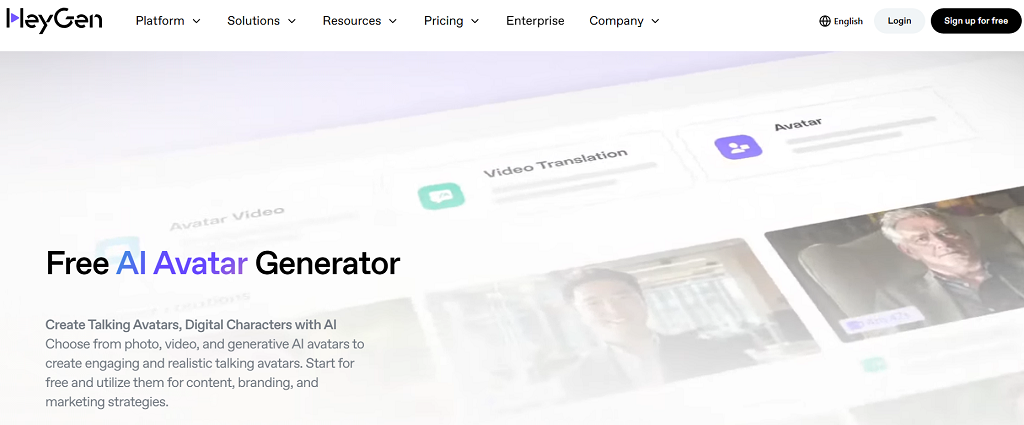
HeyGen feels less like a stiff corporate tool and more like a playground for creators. You can spin up avatars that sell products, narrate social videos, or even test adult-friendly concepts in a safe space. The software leans heavily on flexibility — you’re not stuck with one format. Marketing teams can drop an avatar into promo videos, while independent creators experiment with edgier or NSFW ideas without risking their own face on camera. The editing workflow is smoother than most: drag, drop, adjust, render.
Pros: creative freedom, good balance between pro use and casual creators, NSFW-friendly flexibility.
Cons: still maturing compared to giants like Synthesia, occasional quirks in lip sync.
Replika
Replika takes avatars in a different direction. Instead of polished corporate presenters, it focuses on companionship and conversation. You design an avatar, chat with it, and over time it learns your habits. For some, it’s a wellness tool; for others, it slides into emotional support or even intimate territory. It’s one of the few services where people form genuine attachments to their avatars, sometimes stronger than with real contacts. That mix of empathy and persistence is its unique edge.
Pros: strong conversational depth, personalized interactions, emotionally engaging.
Cons: limited to chat and light roleplay, not built for polished video production.
D-ID
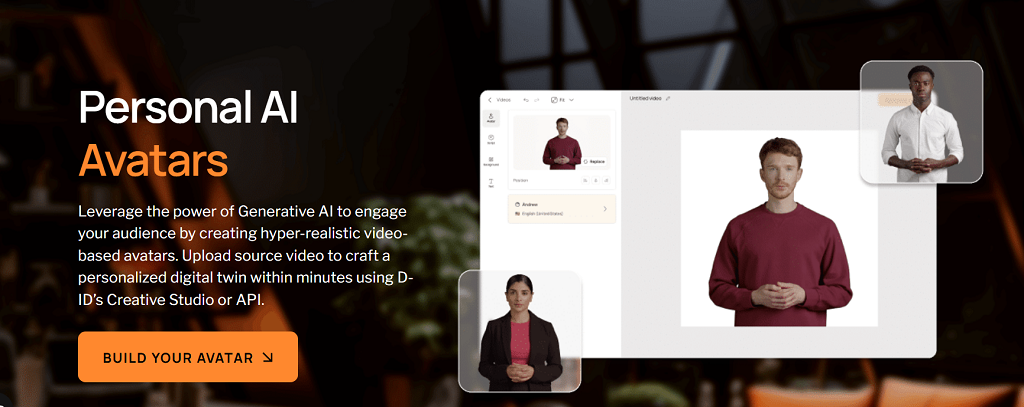
D-ID is best known for turning still images into moving, talking avatars. Upload a portrait, feed it text or audio, and suddenly the image starts speaking with realistic lip sync. For history projects, marketing campaigns, or even adult-themed photo-to-video experiments, it opens doors without needing a live performer. The tool is simple to use but surprisingly effective at creating a sense of presence from nothing more than a headshot.
Pros: quick results, unique “photo to video” capability, easy to learn.
Cons: mostly limited to head-and-shoulder avatars, output can look repetitive if pushed too far.
Why Scrile AI Stands Out
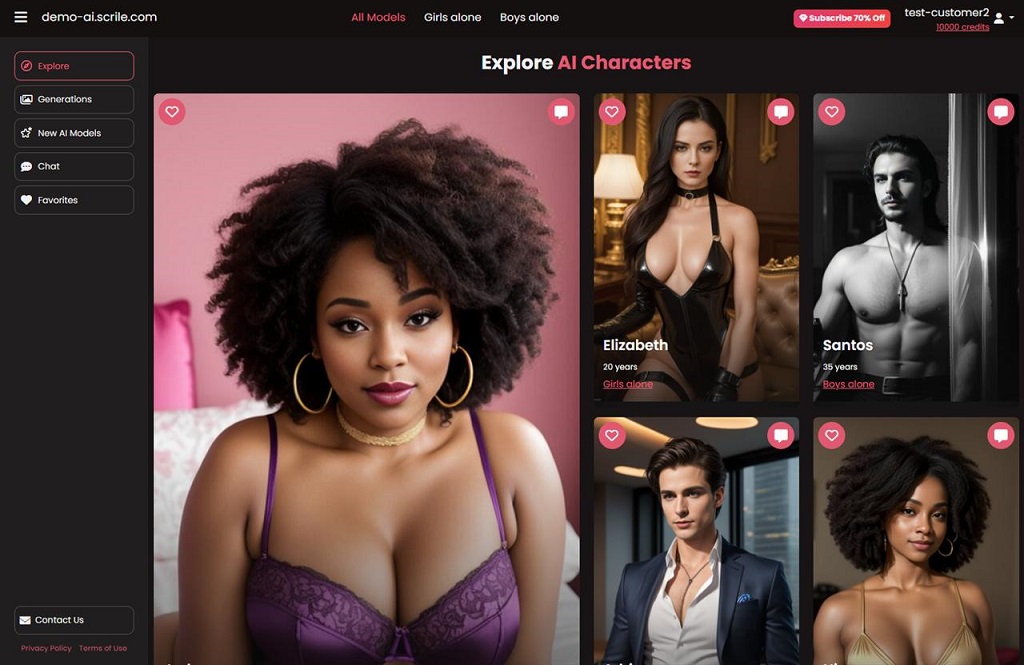
Most of the tools we’ve covered so far are ready-made platforms. They’re great for quick use but come with limits: you rent space, you follow someone else’s rules, and you give up a slice of revenue. Scrile AI goes in a different direction. It isn’t a platform — it’s a development service that lets you build an AI avatar business on your own terms.
The biggest difference is ownership. With Scrile AI, the product wears your brand, not theirs. You control the domain, the design, and the interface. That means your audience sees your name, your colors, and your style — not another company’s watermark.
What Scrile AI provides out of the box is impressive:
- Avatar builder that lets you create characters with unique looks and personalities.
- Integration with leading LLMs (GPT, Claude, Gemini), so your avatars can chat, roleplay, or run scripts.
- Adult-friendly features that make NSFW use cases not only possible but polished.
- Flexible monetization — subscriptions, pay-per-chat, tipping, and bundles.
For anyone asking what is an AI avatar in the context of business, Scrile AI is the answer that goes beyond experiments. Instead of being locked into a SaaS plan with fixed options, you get a system that adapts to your goals. That flexibility makes it valuable for startups chasing new niches, creators looking to launch adult-focused services, or enterprises that want to add avatars without handing over revenue to a third party.
Scrile AI doesn’t just hand you a tool. It hands you the keys to an entire ecosystem that’s yours to scale.
Conclusion
Avatars have moved from curiosity to everyday tools. They’re shaping how people learn, play, work, and even build intimacy online. The five software picks we looked at each serve a purpose — from text-to-video production to companionship apps — and they show just how wide the field has become. But none of them hand over full control.
That’s where Scrile AI changes the picture. Instead of renting space on someone else’s platform, you get the chance to build your own. Your brand, your design, your rules. For businesses and creators who want to turn avatars into a real venture, that kind of ownership is the edge that matters.
If you’re ready to explore what’s possible, reach out to the Scrile AI team. They’ll help you create something that isn’t just another tool, but a system designed around your goals.
Polina Yan is a Technical Writer and Product Marketing Manager, specializing in helping creators launch personalized content monetization platforms. With over five years of experience writing and promoting content, Polina covers topics such as content monetization, social media strategies, digital marketing, and online business in adult industry. Her work empowers online entrepreneurs and creators to navigate the digital world with confidence and achieve their goals.
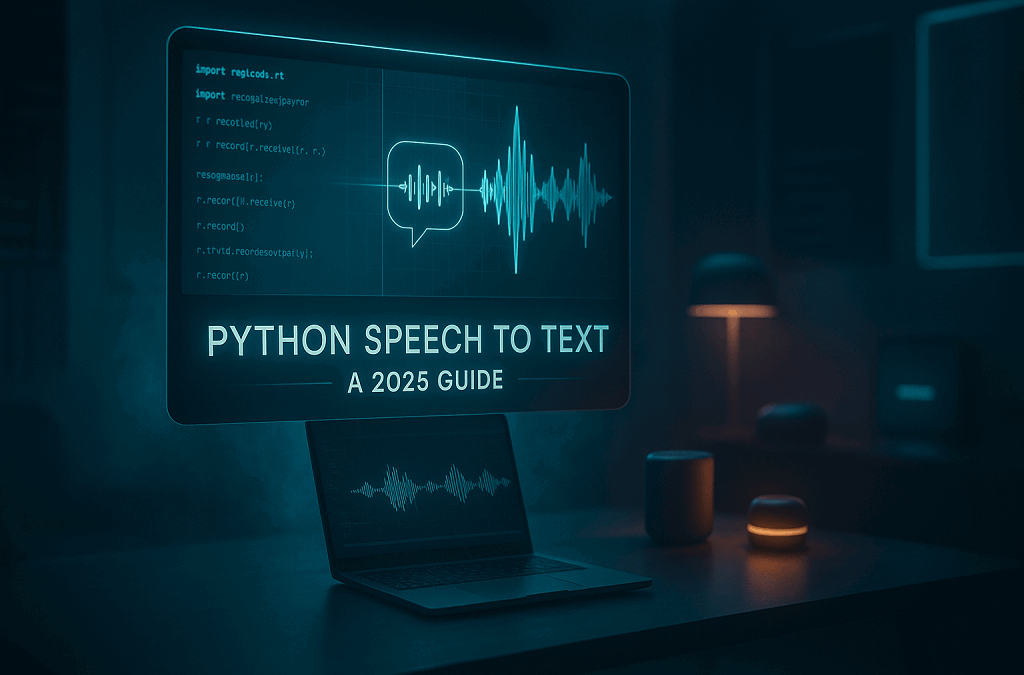
by Polina Yan
People talk to their devices every day — asking for directions, dictating notes, or letting an app transcribe a meeting. None of that feels unusual anymore. What makes it work under the hood is speech recognition, and in the developer world it often comes down to python speech to text. With a few open-source libraries and some smart models, spoken language can be turned into readable text in real time.
This article looks at the tools and methods that make it possible in 2025. We’ll cover the Python libraries most people start with, the role of deep learning in making recognition accurate, and the difference between running speech models offline or through cloud APIs. We’ll also look at real-world uses like streaming captions and business workflows, plus the option to build fully custom solutions when standard tools aren’t enough.
How Speech Recognition Works
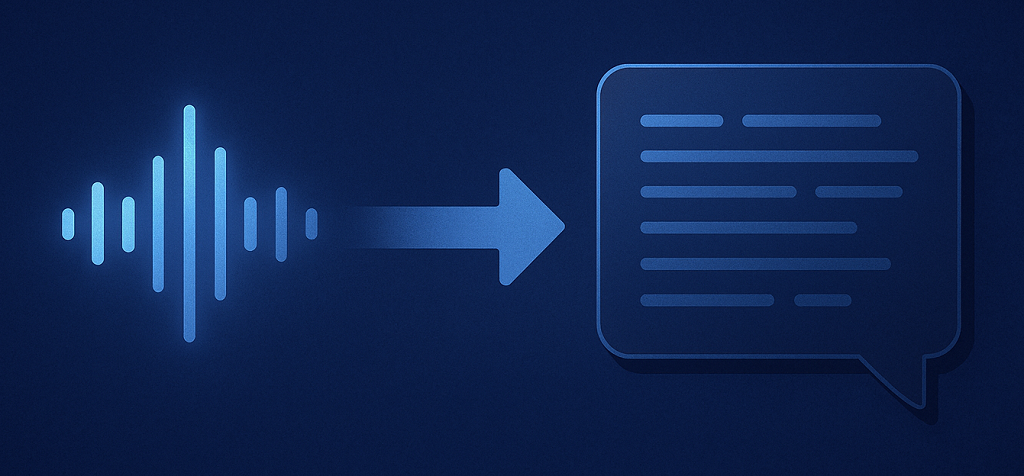
Take any sound you make — it starts as vibrations in the air. A microphone catches them and slices the noise into tiny frames of data. The software then paints those pieces into a spectrogram, basically a picture showing which frequencies were strong at each moment. From there, the system tries to catch phonemes, the small sound units that build words.
Two brains are working together here: the acoustic model figures out which sounds you actually made, while the language model guesses what you probably meant in context. That’s how “recognize speech” doesn’t come out as “wreck a nice beach.”
What changed the game was machine learning. Hand-crafted rules and early statistical tricks couldn’t handle messy audio or accents. But once deep learning came in, accuracy jumped from rough 70% to well above 90%. Suddenly, voice typing on your laptop or phone didn’t feel like a gimmick anymore.
In practice the flow is:
- Record audio → slice it into frames
- Turn it into a spectrogram
- Match sound patterns with an acoustic model
- Let the language model form words and sentences
That mix of math, context, and neural nets is what makes speech recognition feel almost effortless today.
Popular Python Speech to Text Libraries

When diving into python speech to text, the library you choose shapes everything — accuracy, speed, cost, and whether you can even run your code offline. Let’s break down the most popular ones developers rely on in 2025.
| Library / Tool | Best For | Pros | Cons | Pricing / License |
|---|
| SpeechRecognition | Beginners, quick demos, class projects | Easy to use, works with multiple engines (Google, CMU Sphinx, etc.), minimal setup | Lower accuracy than deep learning models, limited customization | Open-source (MIT), free to use |
| Vosk | Offline apps, IoT devices, Raspberry Pi | Lightweight, runs on low-power devices, >20 languages supported | Models less accurate than Whisper, limited advanced features | Open-source (Apache 2.0), free |
| DeepSpeech / Coqui STT | Custom domain-specific transcription (e.g., medical, legal) | Trainable on custom datasets, full control over models, good accuracy | Requires GPU resources, setup is complex | Open-source (MPL 2.0), free |
| Whisper (OpenAI) | High-accuracy transcription, noisy audio, multilingual | Excellent accuracy, robust to accents/noisy input, dozens of languages | Heavy on resources, slower on CPU-only systems | Open-source (MIT), free; API pricing if using OpenAI’s hosted service |
SpeechRecognition
This library is often the first stop for newcomers. It’s easy to install, easy to use, and works out of the box with just a few lines of Python code. SpeechRecognition connects to different engines, including Google Web Speech API and CMU Sphinx for offline tasks. While it won’t deliver the same precision as heavy deep learning models, it’s perfect for quick demos, class projects, or small apps where setup speed matters more than accuracy.
Vosk
If you want python speech to text without depending on the cloud, Vosk is a strong option. It’s lightweight, efficient, and supports more than 20 languages. Developers often use it in Raspberry Pi projects, IoT devices, and mobile apps that can’t send constant requests to online servers. Vosk models are smaller compared to neural giants like Whisper, but that makes them fast, memory-friendly, and practical for real-world applications.
DeepSpeech and Coqui STT
Mozilla’s DeepSpeech introduced the idea of open-source deep learning for speech recognition, and Coqui STT now carries the torch. Both libraries use recurrent neural networks under the hood and can be fine-tuned with domain-specific data. That means if you’re building a medical or legal transcription tool, you can train the models to handle industry jargon. These projects require GPU power and patience, but the payoff is flexible, customizable models that you fully control.
Whisper (OpenAI)
Whisper is the current heavyweight among python voice to text tools. It supports dozens of languages, handles noisy or low-quality audio better than most alternatives, and shines in tasks like podcast transcription or video subtitling. It’s GPU-friendly, so running it locally is possible if you’ve got the hardware. The tradeoff is resource usage — Whisper is not as light as Vosk, but the accuracy gain is often worth it.
Choosing the Right Tool
Each library fits a different purpose. SpeechRecognition is great for quick wins, Vosk for offline apps, DeepSpeech/Coqui for custom training, and Whisper for cutting-edge accuracy. Your choice depends on whether you value simplicity, independence, or raw performance.
Speech to Text with Deep Learning
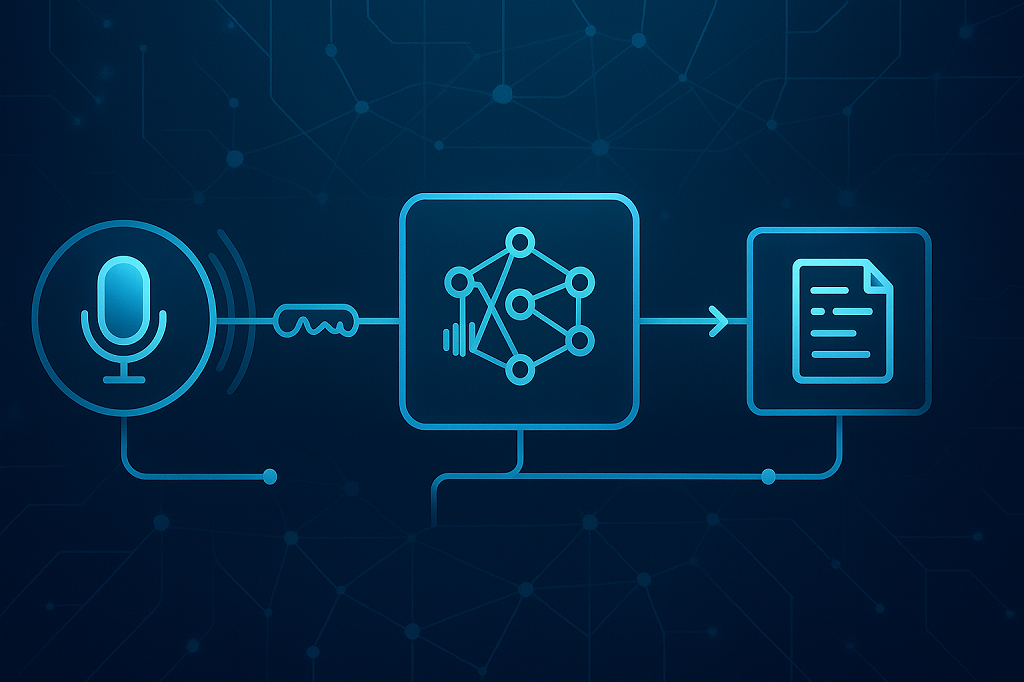
Before neural networks entered the field, speech recognition felt clunky — good for dictation, not much else. The last decade changed everything. Models got smarter, faster, and now speech can be converted into text in real time with surprising accuracy. That leap came directly from advances in speech to text deep learning.
Why Deep Learning Changed Everything
Traditional systems split speech recognition into multiple stages — signal processing, acoustic modeling, and language modeling. Deep learning stitched these parts together with end-to-end neural networks. Instead of engineers hand-tuning features, the network learns directly from massive datasets of audio and transcripts.
That shift boosted accuracy to levels once thought impossible. Real-time transcription is no longer just a demo feature — it’s reliable enough for live captioning, online meetings, and multilingual customer support. The models can adapt to different accents and background noise, making them practical outside the lab.
Frameworks & Models
Deep learning owes much of its momentum to powerful frameworks. TensorFlow and PyTorch dominate, offering developers tools to train, fine-tune, and deploy models. On top of these, pre-trained architectures like OpenAI’s Whisper and Facebook’s Wav2Vec2 set the bar for performance. Both use transformers — the same technology powering modern large language models — to recognize speech across dozens of languages.
In business, this technology is already everywhere: call centers use it to monitor conversations and analyze sentiment, while hospitals deploy it for medical transcription, saving doctors hours of manual note-taking.
The bottom line? Deep learning didn’t just make speech recognition better — it made it practical, flexible, and ready for scale.
Real-Time Speech to Text in Python

Turning spoken words into text while someone is still speaking is a different challenge from batch transcription. The main obstacle is speed: every millisecond counts. If a system lags, captions fall behind or chatbots respond awkwardly. Developers working with Python constantly wrestle with the balance between accuracy and latency.
Some of the most common use cases for real-time systems include:
- Live captioning for online events, classes, and conferences
- Streaming platforms where creators need instant subtitles
- Customer service bots that listen, process, and reply without noticeable delay
To make this work, Python libraries like Vosk and Whisper provide microphone input handling paired with WebSocket streaming. Audio chunks are captured, converted to features, and sent to a recognition model in near real time. The model then returns the text piece by piece, so the user never feels left behind.
Hardware matters just as much as code. GPU acceleration is key — it allows complex neural models to operate with only a fraction of a second of lag. That’s what transforms machine learning speech to text from a neat experiment into a dependable business tool.
When tuned correctly, these pipelines feel invisible. Users don’t think about the recognition layer at all; they just see accurate captions or get instant responses. That invisible layer is exactly what makes real-time transcription one of the most exciting areas of modern Python development.
Business Applications in 2025
Speech recognition is no longer a experimental functionality — it’s a business application in daily usage. Businesses of all types are employing speech recognition to reduce tedious work, facilitate communication, and deliver service to individuals.
Among its largest users are:
- Healthcare: doctors dictate medical notes while systems instantly generate structured records.
- Legal: courtrooms and law offices use dictation software for contracts and case transcripts.
- Media: podcasters and broadcasters add subtitles and searchable transcripts in minutes.
- Customer service: AI-powered call agents transcribe and analyze conversations to respond faster.
- Transcription providers: platforms offering human + AI blended services scale faster with automation.
The figures bear out the trend. According to Speech Technology Magazine, the speech technology market is expanding by double-digit percentages and is on course to top $50 billion by 2030, with firms making it simpler to implement machine learning frameworks, especially with cloud infrastructure.
The effect on businesses is simple: they save time keystroking and provide more convenient user experience to those who prefer or need voice interaction and make quicker decisions in real-time analytics. Whatever took a couple of hours of human effort is all achieved within a minute.
Scrile AI: Custom Speech to Text Development

Most businesses start with ready-made APIs for transcription. They’re fast to set up but come with real limits: fixed branding, rising usage costs, and very little control over sensitive data. At some point, scaling organizations realize they need more than just another SaaS subscription.
This is where Scrile AI comes in. It’s not a platform you rent — it’s a development service that builds tailored solutions using speech to text machine learning at the core.
With Scrile AI, companies can shape the product to match their own needs:
- Fully branded UI/UX that looks like part of your ecosystem.
- Flexible deployment — on your own servers or in the cloud.
- Integration with apps you already use, from CRMs to live streaming platforms.
- Multilingual and even NSFW-ready options for industries with special requirements.
The difference becomes clear in real use cases. An edtech company can roll out a private lecture transcription tool, keeping all recordings and notes under its own security policies. A podcast network can embed auto-captioning inside its branded app without relying on an external provider.
Choosing this route means owning the technology, not just paying per request. For businesses thinking long-term, Scrile AI offers a scalable alternative that adapts as they grow, while keeping control of both data and costs.
Conclusion
Python speech-to-text in 2025 has grown into a core technology for businesses that want efficiency and accessibility. Open-source libraries and APIs show what’s possible, but they rarely give companies full control over data, branding, or future scaling. That’s where a tailored path makes sense — and exploring Scrile AI’s custom solutions can be the next step. By reaching out to the Scrile team, businesses can shape speech recognition systems around their exact needs, rather than adapting to someone else’s limits.
Polina Yan is a Technical Writer and Product Marketing Manager, specializing in helping creators launch personalized content monetization platforms. With over five years of experience writing and promoting content, Polina covers topics such as content monetization, social media strategies, digital marketing, and online business in adult industry. Her work empowers online entrepreneurs and creators to navigate the digital world with confidence and achieve their goals.

by Polina Yan
Knowing how to make an AI chatbot in 2025 is less about coding and more about clarity — because AI bots aren’t just hype anymore. They’re running help desks, chatting up customers, selling subscriptions, and even simulating intimacy through NSFW chat experiences like Candy AI.
Whether you’re a solo founder building a niche app or a business owner automating support, chatbots have become essential tools. Some answer FAQs. Others act like personal assistants. A growing number? They’re designed for companionship, education, or paid fan interactions — and users expect them to sound human, remember things, and work across platforms.
You don’t need to be a developer to build one. But you do need to understand how they work, what options exist, and what makes a chatbot actually useful (and not just noisy). This guide breaks it all down — from quick-build tools to custom AI platforms with monetization built in.
Why Chatbots Still Work in 2025
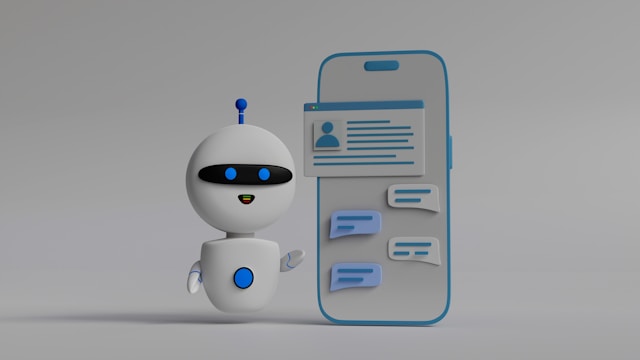
If you’re wondering how to make an AI chatbot that people actually want to use, start with this: the market is thriving. According to Grand View Research In 2025, the global chatbot market is projected to exceed $27 billion, driven by demand across ecommerce, health, entertainment, and adult industries. Bots aren’t replacing humans — they’re augmenting them, doing the repetitive stuff faster and around the clock.
And they work. Studies show that AI-powered chat outperforms static FAQ pages and clunky help forms. Why scroll through a support database when you can just ask a bot?
Here’s where people are using them:
- Ecommerce brands use them as product recommenders and upsell engines.
- Mental health startups are building bots as virtual therapists or check-in partners.
- Hotels and clinics rely on chatbots for bookings and reminders.
- Fan sites and creators use chat to build loyalty through personalized interaction.
- And yes, NSFW AI bots — inspired by services like Candy AI — are becoming a mainstream monetization channel for adult content creators.
People are getting more comfortable chatting with bots, especially when the bot remembers things, responds with nuance, and sounds like an actual personality — not just a script.
If you’re considering creating an AI chatbot for your business or platform, the use cases are wider (and more profitable) than ever. It’s all about building something that feels human — without needing a human on the other end.
Pick Your Bot Type First
Before you even ask how to make an AI chatbot, you need to know what kind of chatbot you’re building — because not all bots are designed to do the same job.
Some bots are built to handle support tickets and help customers navigate FAQs. Others are made to capture leads, qualify prospects, or drive product sales. And increasingly, chatbots are being used for creative and highly personalized experiences — from writing assistants to NSFW AI bots and even fan roleplay companions.
Here are just a few types you might consider:
- Support bots for troubleshooting and onboarding
- Lead capture bots that gather emails and segment traffic
- Writing or knowledge bots to help brainstorm, draft, or summarize
- NSFW-style AI companions for entertainment or monetization
- Character bots or fiction-based personas for fandom interaction
- Booking bots for scheduling and reminders
Every chatbot solves a different problem. And if you’re creating an AI chatbot for a specific use case, getting clear on that problem first will shape every decision: the tone of voice, the backend logic, and the tools you’ll need.
No-Code and Low-Code Options

Not everyone building a chatbot in 2025 is a developer — and the rise of no-code and low-code tools proves that. Platforms like ChatBot.com, Tidio, and Landbot have made it possible for almost anyone to launch a functioning AI assistant in less than a day. These tools offer visual builders, simple logic flows, and pre-built conversation templates, so even someone without a tech background can piece together a working bot.
If you’re running a small business or need a basic virtual assistant, these platforms can do a lot. You might want a chatbot on your Shopify store to handle product questions, process simple returns, or guide customers to the right category. Or maybe you need something that helps book appointments, answers FAQs, or directs visitors to the right department. These tools are ideal for those kinds of jobs.
The biggest benefit of going the no-code route is speed. It’s fast to launch, affordable to test, and easy to manage without a dedicated dev team. You can tweak flows, add messages, and adjust triggers in a visual dashboard with little effort. But with that simplicity comes limitations. These tools aren’t built for deep customization. You can’t always control tone or personality, and memory is often limited to a single session — which can be a dealbreaker for more interactive or emotionally intelligent bots.
For many, though, that trade-off is fine. If your needs are straightforward and your brand doesn’t rely on advanced logic or tone-sensitive replies, these platforms offer a great entry point. Still, if you’re thinking long-term — or want your bot to actually sound human, remember context, or monetize — no-code tools might feel like a short-term fix.
Understanding how to create an AI chatbot is as much about knowing your options as it is about knowing your limits.
Building Your Own: Custom Chatbot Architecture
If you want total control over how your bot looks, talks, and behaves, then you’re probably thinking about going custom. Learning how to make an AI bot from scratch gives you flexibility that no template-based builder can match. This is where things get technical — but it’s also where they get powerful.
The Anatomy of a Custom AI Chatbot
A solid architecture starts with three essential components: the user interface (chat screen or voice interaction), the AI engine, and the logic layer that holds it all together. For the UI, you might use a web or mobile front-end designed in React, Vue, or Flutter. It’s the part the user sees and interacts with. Behind the scenes, the real work happens.
Most modern bots hook into powerful APIs like OpenAI (GPT-4), Claude, or Mistral for generating responses. These engines don’t “understand” in a human sense, but they’re excellent at language prediction, tone matching, and context generation — especially when guided by well-structured prompts.
That’s where prompt engineering comes in. A strong prompt is more than “talk like a pirate.” It’s a carefully crafted instruction set that sets tone, role, memory behavior, and guardrails. You can also integrate LangChain for building logic flows or multi-turn conversations, and tools like Pinecone or Weaviate to manage vector-based memory — so your bot can “remember” things users said days or weeks ago.
You’ll also need a backend — Firebase is a popular choice — to store user data, authentication, and interaction history. Combine this with analytics and optional payment integration, and you’ve got the bones of a real product.
Use cases are only growing. Some developers build bots that write poetry in the user’s tone. Others create Candy AI-style NSFW companions, trained on romantic or explicit fiction and designed for real-time, emotionally adaptive responses.
If you’re considering custom AI chatbot development, this is the route that lets you build exactly what you want. But it also means thinking like a product owner, not just a builder. That’s the trade — freedom for complexity.
What a Good AI Bot Needs in 2025
Building a chatbot is one thing. Building a good one — the kind users actually enjoy talking to — is something else entirely. Whether you’re creating an AI chatbot for a business, a creative project, or something more personal, the difference between “meh” and “wow” usually comes down to a few key features.
Memory is at the forefront. The very best 2025 bots don’t just react in the moment – they remember context. This may involve tracking a user’s name and tastes or reading a series of conversations over several months. Without memory, exchanges become shallow, mechanical, and unmemorable.
There’s also tone. Your bot may not have to feel, at least not in an emotional way, but it will need to respond in ways that will feel empathetic or energetic when required by circumstance. Insert some safety rails and moderation filters, particularly if your bot is dealing with sensitive subjects or NSFW material, and you’ve got something that will feel complete and credible.
Smart bots also connect to other tools. Want to process payments? Integrate with Stripe. Want to notify users or sync to groups? Plug into Telegram or Discord. APIs are your best friend here.
Privacy is another deal-breaker. If your chatbot handles personal or adult interactions, strong privacy controls and user filters are essential. Clear terms, encryption, and opt-in systems go a long way toward building user trust.
Finally, language flexibility is key. A growing number of bots are expected to handle multiple languages or offer seamless translation on the fly — especially when used in global communities.
These aren’t just features. They’re expectations. The bar is higher now, and the bots that stand out are the ones that feel less like widgets — and more like something real.
Scrile AI: Building Custom Chatbots that Work — and Sell

Once you’ve explored prebuilt tools and basic frameworks, one thing becomes clear: real success with chatbots doesn’t come from off-the-shelf options. If you want full creative control, long-term ownership, and real monetization potential, it’s time to think about how to make an ai chatbot with a custom approach.
That’s where Scrile AI stands out. It’s not a plug-and-play chatbot builder or a SaaS subscription with rigid limitations. Scrile AI is a custom development service — a technical team that helps founders, startups, and creators launch their own branded, scalable AI chatbot platforms from scratch.
The difference? You don’t just get a bot — you get an entire product.
Scrile AI specializes in custom chatbot solutions designed for business models where personalization and revenue matter. That includes NSFW platforms, fitness coaching, fan communities, subscription services, and interactive education tools. These aren’t bots bolted onto an existing website — they’re full ecosystems built around user interaction, automation, and monetization.
Some of the use cases Scrile AI delivers:
- Subscription-based customer service bots for SaaS platforms
- Adult AI chatbots like Candy AI — private, monetizable, with built-in pay-per-message models
- Fitness and wellness coaches using chat-based programs, journaling, or daily feedback
- Dating site bots that simulate human conversation with realistic pacing, tone, and memory
- Fan hubs and roleplay platforms where characters interact in real time
And it’s not just about chat. Scrile builds systems that include:
- Custom-designed UIs tailored to your brand
- Full payment integration: Stripe, crypto, PPV, or affiliate models
- Scalable backend infrastructure and long-term chat memory
- Admin dashboards with user analytics and content moderation
- NSFW-friendly setup with privacy layers and content filters
- Voice, avatar, or live cam modules (optional)
Why choose Scrile?
Because launching from scratch doesn’t mean reinventing the wheel — it means skipping generic and building what actually fits.
With Scrile, you get:
- Fast time to market with agile rollout plans
- No vendor lock-in — you own everything
- Customization at every level, from UX to AI personality
- Clear pathways to monetize without third-party rules
If you’re looking for custom chatbot solutions that actually serve your business, Scrile AI gives you the control, tools, and support to make it real — and profitable.
Conclusion
The chatbot space in 2025 is more powerful and more versatile than ever. Whether you’re building a friendly customer service assistant, a creative storytelling bot, or even a romantic AI companion inspired by platforms like Candy AI, the tech is there — and it’s surprisingly accessible.
You no longer need a massive dev team or a year-long roadmap to launch something functional. If you just want a simple bot that handles support or collects leads, no-code platforms can get you going fast. But if your goals include deeper personalization, real AI memory, monetization, or NSFW functionality, that’s where things shift. The question isn’t just how to make an AI chatbot, but how to make one that actually reflects your idea — your brand, your voice, your audience.
And that’s where custom development makes all the difference. You get total control, data ownership, and the freedom to build a product that grows with you — not within someone else’s limitations.
Scrile AI was built for that purpose. They’re not handing you a template. They’re helping you create something original, branded, and ready to launch — fast.
If you’re ready to stop renting chatbot tools and start owning your vision, talk to Scrile AI. They’ll help you build the chatbot you’ve been imagining — and make it something users will actually want to talk to.
Polina Yan is a Technical Writer and Product Marketing Manager, specializing in helping creators launch personalized content monetization platforms. With over five years of experience writing and promoting content, Polina covers topics such as content monetization, social media strategies, digital marketing, and online business in adult industry. Her work empowers online entrepreneurs and creators to navigate the digital world with confidence and achieve their goals.
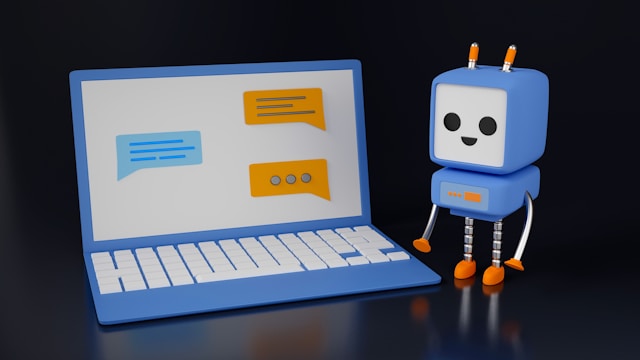
by Polina Yan
Ever found yourself staring blankly at a message, struggling to find the right words? Whether it’s drafting a quick reply for a dating app, crafting a thoughtful response on a creator’s platform, or managing endless social media comments, sometimes you just need a little help. That’s where an AI answer generator steps in—offering quick, smart, and contextually relevant replies at the tap of a button.
In 2025, AI answer generators are more than just fancy text tools; they are becoming essential for creators, social media managers, and businesses looking to maintain engagement without losing a personal touch. In this article, we’ll dive into the best AI answer generators available today, showcasing tools that not only save time but also enhance the quality of interactions. Let’s explore how these AI tools can elevate your communication strategy, making every interaction more efficient, engaging, and stress-free in 2025!
What is an AI Answer Generator?
An AI answer generator is a smart tool designed to transform raw queries into well-structured, relevant answers. It acts as a virtual assistant, interpreting questions and crafting responses that feel natural and on-point. These tools are particularly valuable for streamlining communication on creator websites, dating platforms, social media, and even adult websites, where maintaining engagement and providing quick replies are crucial.
At its core, an AI answer generator relies on technologies like Natural Language Processing (NLP) and machine learning. These technologies analyze the input, understand context and intent, and generate answers that match the tone and style of the platform. Whether it’s an AI question answer generator or a discussion post reply generator, the goal is to deliver responses that enhance user interactions and save time. And with options like free AI answer generators, even small platforms can leverage this technology to boost their efficiency and maintain a vibrant online presence.
Benefits of Using AI Answer Generators

AI answer generators offer a powerful set of advantages, making life easier for creators, influencers, social media managers, and digital businesses:
- Time Efficiency: With an answer generator, hours of typing and overthinking can be reduced to mere seconds.
- Consistency and Accuracy: Instead of manually crafting each response, an AI generator answers with the same tone and precision, reducing the chance of errors and keeping communication on-brand.
- Real-World Impact: A dating platform, for instance, integrated an AI answer generator to manage repetitive user queries. The result? A 40% boost in response speed and happier users who received instant, accurate answers.
- Versatility Across Use Cases: For creators, an AI question answer generator can help engage audiences by generating thoughtful replies to comments. Social media managers can use AI generated answers to handle large volumes of messages without losing the human touch.
Top 5 AI Answer Generator Tools in 2025
When it comes to finding the best AI answer generator in 2025, there are plenty of options on the market, each offering unique features and benefits:
ChatGPT

ChatGPT by OpenAI continues to lead the pack as a versatile and powerful AI answer generator. Built on the advanced GPT-4 architecture, ChatGPT excels at generating smart and contextually accurate responses for everything from discussion posts to chat interactions and customer support queries.
One of the standout features of ChatGPT is its ability to maintain a consistent voice while adapting to different communication styles. For example, a content creator managing a vibrant online community can use ChatGPT to generate thoughtful replies to fan comments, keeping engagement high without feeling repetitive or automated. The tool’s flexibility also makes it perfect as an AI discussion post generator in real-time, whether through a social media chat or a Q&A forum on a creator’s website.
Jasper AI
If you’re looking for a polished and professional answer generator, Jasper AI is a top choice, particularly for marketing and content-driven platforms. Jasper is designed to create well-structured and articulate responses, making it an ideal fit for scenarios where maintaining a specific tone or brand voice is crucial.
A practical example of Jasper’s use is on a creator’s website where maintaining engagement with fans is essential. Jasper can help generate thoughtful replies to fan inquiries, ensuring responses are not only quick but also meaningful and brand-consistent. Whether it’s responding to questions on a blog, managing comments on a video platform, or creating tailored replies for email interactions, Jasper’s AI capabilities can significantly enhance communication efficiency.
Writesonic
Writesonic is known for delivering quick and creative answers, making it an excellent tool for social media managers and content creators. This AI answer generator free option shines in generating witty and engaging responses, particularly useful in fast-paced environments like social media where maintaining a brand’s voice consistently is key.
A real-world scenario where Writesonic excels is in handling high volumes of social media comments. Whether it’s responding to followers on Instagram or managing conversations on a dating app, Writesonic generates replies that feel genuine and on-brand.
Claude AI
Claude AI, developed by Anthropic, is a relatively new player in the AI answer generator market but has quickly gained traction for its conversational and context-aware responses. Unlike many AI tools, Claude focuses on generating answers that feel human and maintain a natural flow of conversation.
A notable feature of Claude AI is its ability to understand nuanced queries and provide detailed, thoughtful answers. This makes it an ideal choice for platforms that prioritize engagement and authenticity, such as dating apps, creator websites, and social media forums.
Tidio AI
For small businesses and startups, Tidio AI offers a practical and cost-effective solution. Tidio specializes in automating responses for customer support and basic interaction management, making it a smart choice for e-commerce sites and small digital communities.
Tidio’s easy integration with platforms like Shopify and WordPress makes it particularly useful for businesses that need a straightforward and affordable answer generator without compromising on quality or functionality.
Why Scrile Connect’s Answer Generator is the Best Choice

Scrile Connect offers a unique approach to AI-generated answers, especially for niche markets like creator websites, dating platforms, social media, and adult content sites. Instead of offering a one-size-fits-all solution, Scrile Connect provides fully customizable tools that adapt to specific communication needs.
Its standout feature is contextual understanding, analyzing past interactions to deliver personalized responses. This is ideal for platforms where audience connection is key—such as generating thoughtful replies on adult fan sites or managing engaging chats on dating apps.
Scrile Connect also supports dynamic conversation phrases, allowing seamless transitions from casual chats to targeted sales interactions or more intimate exchanges. This adaptability helps maintain engagement and authenticity across all types of interactions.
For creators looking to monetize their AI tools, Scrile Connect offers the flexibility to build bespoke platforms, enabling direct sales of AI-generated answers, art, or other digital assets. This approach ensures full control over branding and revenue while fostering a dedicated community around your unique offerings.
Conclusion
Scrile’s AI answer generator offers a dynamic and customizable solution for enhancing communication strategies. If you’re ready to boost engagement and streamline responses with intelligent, human-like answers, explore how Scrile’s bespoke AI tools can elevate your platform’s communication game today!
Polina Yan is a Technical Writer and Product Marketing Manager, specializing in helping creators launch personalized content monetization platforms. With over five years of experience writing and promoting content, Polina covers topics such as content monetization, social media strategies, digital marketing, and online business in adult industry. Her work empowers online entrepreneurs and creators to navigate the digital world with confidence and achieve their goals.




































